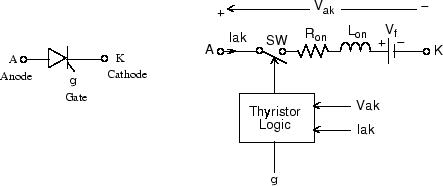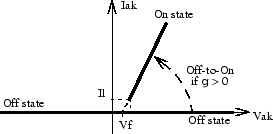Thyristor
(To be removed) Implement thyristor model
The Specialized Power Systems library will be removed in R2026a. Use the Simscape™ Electrical™ blocks and functions instead. For more information on updating your models, see Upgrade Specialized Power System Models to use Simscape Electrical Blocks.
Libraries:
Simscape /
Electrical /
Specialized Power Systems /
Power Electronics
Description
The thyristor is a semiconductor device that can be turned on via a gate signal. The thyristor model is simulated as a resistor Ron, an inductor Lon, and a DC voltage source representing the forward voltage Vf, connected in series with a switch. The switch is controlled by a logical signal depending on the voltage Vak, the current Iak, and the gate signal g.

The Thyristor block also contains a series Rs-Cs snubber circuit that can be connected in parallel with the thyristor device.
The static VI characteristic of this model is shown below.

The thyristor device turns on when the anode-cathode Vak voltage is greater than Vf and a positive pulse signal is applied at the gate input (g > 0). The pulse height must be greater than 0 and last long enough to allow the thyristor anode current to become larger than the latching current Il.
The thyristor device turns off when the current flowing in the device becomes 0 (Iak = 0) and a negative voltage appears across the anode and cathode for at least a period of time equal to the turnoff time Tq. If the voltage across the device becomes positive within a period of time less than Tq, the device turns on automatically even if the gate signal is low (g = 0) and the anode current is less than the latching current. Furthermore, if during turn-on, the device current amplitude stays below the latching current level specified in the dialog box, the device turns off after the gate signal level becomes low (g = 0).
The turnoff time Tq represents the carrier recovery time: it is the time interval between the instant the anode current has decreased to 0 and the instant when the thyristor is capable of withstanding positive voltage Vak without turning on again.
Assumptions and Limitations
The Thyristor block implements a macro model of the real thyristor. It does not take into account either the geometry of the device or complex physical processes that model the behavior of the device [1, 2]. The forward breakover voltage and the critical value of the derivative of the reapplied anode-cathode voltage are not considered by the model.
Depending on the value of the inductance Lon, the Thyristor block is modeled either as a current source (Lon > 0) or as a variable topology circuit (Lon = 0). The Thyristor block cannot be connected in series with an inductor, a current source, or an open circuit, unless its snubber circuit is in use.
The inductance Lon is forced to 0 if you choose to discretize your circuit.
Ports
Input
Output
Conserving
Parameters
References
[1] Rajagopalan, V., Computer-Aided Analysis of Power Electronic Systems, Marcel Dekker, Inc., New York, 1987.
[2] Mohan, N., T.M. Undeland, and W.P. Robbins, Power Electronics: Converters, Applications, and Design, John Wiley & Sons, Inc., New York, 1995.
Extended Capabilities
Version History
Introduced before R2006a